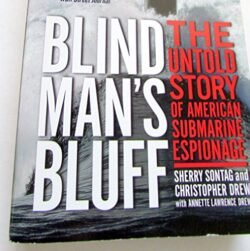“Blind Man’s Bluff: The Untold Story of American Submarine Espionage” by Sherry Sontag, Christopher Drew, and Annette Lawrence Drew, first published in 1998, is a gripping account of the secretive world of submarine espionage during the Cold War. The book sheds light on the dangerous and clandestine operations of the U.S. Navy’s submarine force, revealing how American submarines covertly tracked Soviet submarines and tapped undersea cables, gathering crucial intelligence. Through detailed research and interviews with key figures involved in these missions, “Blind Man’s Bluff” uncovers the high-stakes games of cat and mouse played beneath the waves, offering insights into the technological innovations and human courage that played a critical role in these operations. Character Analysis As a non-fiction work focused on historical events, “Blind Man’s Bluff” does not feature characters in the traditional sense but highlights real-life naval officers, crew members, and intelligence operatives. These individuals are portrayed through their involvement in various espionage missions, showcasing their bravery, ingenuity, and dedication to their covert tasks. Themes and Analysis Secrecy and Espionage: The book explores the theme of secrecy in military operations, detailing the lengths to which the U.S. Navy went to gather intelligence on Soviet naval capabilities without detection. Technological Warfare: “Blind Man’s Bluff” highlights the role of technological innovation in Cold War espionage, including the development of sophisticated listening devices and the risks involved in deploying them. Ethical and Political Dilemmas: The narrative also delves into the ethical and political implications of submarine espionage, questioning the morality of spying and the potential consequences of these actions on international relations. “Blind Man’s Bluff: The Untold Story of American Submarine Espionage” provides a fascinating glimpse into a largely hidden aspect of Cold War history. By combining thorough research with compelling storytelling, the authors offer a detailed account of the daring and dangerous world of submarine espionage. The book not only pays tribute to the unsung heroes of these missions but also prompts readers to consider the broader implications of espionage on global politics and security. “Blind Man’s Bluff” is an essential read for those interested in military history, naval warfare, and the complex interplay of technology and intelligence in the shadowy depths of the Cold War. If the summary caught your interest, Consider reading the full book on AbeBooks. Explore this book on AbeBooks
We Were Soldiers Once.and Young: Ia Drang – The Battle That Changed the War in Vietnam
“We Were Soldiers Once…and Young: Ia Drang – The Battle That Changed the War in Vietnam” by Lt. Gen. Harold G. Moore (Ret.) and Joseph L. Galloway is a riveting account of the first major battle between the U.S. Army and the North Vietnamese forces in November 1965. This book provides a detailed and harrowing depiction of the Battle of Ia Drang, where Moore commanded the 1st Battalion, 7th Cavalry Regiment. Through firsthand experiences, the authors offer a profound insight into the realities of combat, the bonds formed among soldiers, and the strategies that defined the early stages of the Vietnam War. Character Analysis Lt. Gen. Harold G. Moore (Ret.): Moore is not only a co-author but also a central figure in the narrative, showcasing exemplary leadership and tactical acumen during the Battle of Ia Drang. His character exemplifies courage, compassion, and a deep sense of responsibility towards his men. Moore’s leadership style and decision-making processes under extreme pressure provide readers with a nuanced understanding of what it means to command in the heat of battle. Joseph L. Galloway: Galloway, a journalist and the other co-author, offers a unique civilian perspective on the conflict. Present during the battle, his observations and experiences add a layer of journalistic detail that complements Moore’s military insights. Galloway’s character represents the bravery and dedication of war correspondents, risking their lives to document the truth of warfare. Themes and Analysis The Brutality and Brotherhood of War: The book starkly portrays the brutal realities of combat while also highlighting the unbreakable bonds of brotherhood that form among soldiers. The personal stories of survival, sacrifice, and loss are a testament to the human spirit’s resilience. Leadership in Crisis: Through Moore’s experiences, the narrative delves into the essence of leadership during times of crisis, emphasizing the importance of decision-making, moral courage, and the welfare of subordinates. Historical and Tactical Insights: The Battle of Ia Drang is analyzed not just as an event but as a turning point that offered critical lessons for future military engagements in Vietnam, showcasing the importance of tactics, terrain, and the enemy’s capabilities. “We Were Soldiers Once…and Young” stands as a powerful testament to the courage and sacrifice of the soldiers who fought in the Battle of Ia Drang. Moore and Galloway’s firsthand account provides an invaluable perspective on the complexities of the Vietnam War, offering a blend of strategic analysis, personal valor, and the harsh truths of armed conflict. This book not only memorializes those who served and sacrificed in Ia Drang but also serves as a crucial historical document that sheds light on the profound impact of this battle on the course of the Vietnam War. For military historians, veterans, and anyone interested in understanding the realities of war, this work is an essential read, capturing the essence of human endurance and the indomitable spirit of those who serve in uniform. If the summary caught your interest, Consider reading the full book on AbeBooks. Explore this book on AbeBooks


